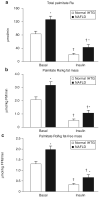Alterations in fatty acid kinetics in obese adolescents with increased intrahepatic triglyceride content
- PMID: 18948971
- PMCID: PMC2649753
- DOI: 10.1038/oby.2008.494
Alterations in fatty acid kinetics in obese adolescents with increased intrahepatic triglyceride content
Abstract
Objective: It has been hypothesized that excessive fatty acid availability contributes to steatosis and the metabolic abnormalities associated with nonalcoholic fatty liver disease (NAFLD). The purpose of this study was to evaluate whether adipose tissue lipolytic activity and the rate of fatty acid release into plasma are increased in obese adolescents with NAFLD.
Methods: Palmitate kinetics were determined in obese adolescents with normal (n = 9; BMI = 37 +/- 2 kg/m(2); intrahepatic triglyceride (IHTG) <or=5.5% of liver volume) and increased (n = 9; BMI = 36 +/- 2 kg/m(2); IHTG >or= 10% of liver volume) IHTG content during the basal state (postabsorptive condition) and during physiological hyperinsulinemia (postprandial condition). Both groups were matched on body weight, BMI, percent body fat, age, sex, and Tanner stage. The hyperinsulinemic-euglycemic clamp procedure, in conjunction with a deuterated palmitate tracer infusion, was used to determine free-fatty acid (FFA) kinetics, and magnetic resonance spectroscopy was used to determine IHTG content.
Results: The rate of whole-body palmitate release into plasma was greater in subjects with NAFLD than those with normal IHTG content during basal conditions, (87 +/- 7 vs. 127 +/- 13 micromol/min; P < 0.01) and during physiological hyperinsulinemia, (24 +/- 2 vs. 44 +/- 8 micromol/min; P < 0.01).
Discussion: These results demonstrate that adipose tissue lipolytic activity is increased in obese adolescents with NAFLD and results in an increase in the rate of fatty acid release into plasma throughout the day. This continual excess in fatty acid flux supports the hypothesis that adipose insulin resistance is involved in the pathogenesis of steatosis and contributes to the metabolic complications associated with NAFLD.
Figures

References
-
- Sagi R, Reif S, Neuman G, et al. Nonalcoholic fatty liver disease in overweight children and adolescents. Acta Paediatr. 2007;96:1209–1213. - PubMed
-
- Lerret SM, Skelton JA. Pediatric nonalcoholic fatty liver disease. Gastroenterol Nurs. 2008;31:115–119. - PubMed
-
- Tominaga K, Kurata JH, Chen YK, et al. Prevalence of fatty liver in Japanese children and relationship to obesity. An epidemiological ultrasonographic survey. Dig Dis Sci. 1995;40:2002–2009. - PubMed
-
- Franzese A, Vajro P, Argenziano A, et al. Liver involvement in obese children. Ultrasonography and liver enzyme levels at diagnosis and during follow-up in an Italian population. Dig Dis Sci. 1997;42:1428–1432. - PubMed
Publication types
MeSH terms
Substances
Grants and funding
- DK 37948/DK/NIDDK NIH HHS/United States
- P30 DK056341/DK/NIDDK NIH HHS/United States
- UL1 RR024992/RR/NCRR NIH HHS/United States
- P41 GM103422/GM/NIGMS NIH HHS/United States
- UL1 TR000448/TR/NCATS NIH HHS/United States
- RR-00954/RR/NCRR NIH HHS/United States
- RR024992/RR/NCRR NIH HHS/United States
- R24 GM136766/GM/NIGMS NIH HHS/United States
- KL2 TR000450/TR/NCATS NIH HHS/United States
- R01 DK037948/DK/NIDDK NIH HHS/United States
- KL2 RR024994/RR/NCRR NIH HHS/United States
- DK 56341/DK/NIDDK NIH HHS/United States
- P41 RR000954/RR/NCRR NIH HHS/United States
LinkOut - more resources
Full Text Sources
Medical

